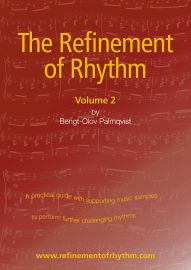
The Refinement of Rhythm, volume 2 music sample for download
Artikelnummer
9789187710445
Kategori
Rytmlära
Textförfattare
Palmqvist Bengt-Olov
275 kr
The Refinement of Rhythm is a comprehensive, explanatory manual of progressive practical studies, supported by a collection of innovative music samples, to develop a thorough and systematic rhythmic understanding.
"The Refinement of Rhythm is the first fully comprehensive textbook, to my knowledge, that actually teaches the art of rhythmic performance in finely tuned incremental stages. It is a masterpiece of logical and systematic methodology, format and layout. It is a book to be used as part of a complete course of instruction as well as providing a compelling and authoritative tool for self study"
Professor Michael R Rogers,
Kenneth and Bernadine Endowed Professor (emeritus) of Music Theory, University of Oklahoma
Founding Editor, Journal of Music Theory Pedagogy
The Refinement of Rhythm series is designed for all musicians regardless of instrument or preferred style of music. The requirements for rhythmic understanding and musical appreciation have no barrier across either instrument or musical genres. It does not conform to any particular examination syllabus, which can distract from the development of a solid overall skill base.
Volume 1 contains 16 chapters and Volume 2 (for more advanced students) has 20 chapters, introducing all of the various concepts and facets of rhythm. The material ranges from very simple longer note and rest values, simple divisions (duple and triple) and subdivisions of the basic beat, leading to single dotted and double dotted figures, upbeats, inverted dotted figures, syncopation and unaccented beats, hemiolas, and then to simple polyrhythms (triplets, duplets and quadruplets), complex polyrhythms, (quintuplets and septuplets) and asymmetrical meters (quintuple and septuple meters).
Each chapter is similarly structured, consisting of the following sections:
Explanatory Text
Preparatory Exercises
Melodic Exercises (including Drills)
Canons
Improvisations
Music References for Further Study
The exercises have been composed melodically, since the end result of rhythmic development should be an improvement in musicality. Most of the exercises also include simple chord symbols to add colour and vitality, and are recorded on to the accompanying music samples using a harmonised backing. Each publications includes appendices of theoretical help, including names of rhythmic note and rest values, signs and symbols, chord charts, chord realisations and a detailed glossary.
In addition, each volume also has a supplemetary publication focusing specifically on the methodology for rhythmic dictation (Volume 1 and Volume 2). Transposition of the musical examples are available as additional supplements by request.
"The Refinement of Rhythm is the first fully comprehensive textbook, to my knowledge, that actually teaches the art of rhythmic performance in finely tuned incremental stages. It is a masterpiece of logical and systematic methodology, format and layout. It is a book to be used as part of a complete course of instruction as well as providing a compelling and authoritative tool for self study"
Professor Michael R Rogers,
Kenneth and Bernadine Endowed Professor (emeritus) of Music Theory, University of Oklahoma
Founding Editor, Journal of Music Theory Pedagogy
The Refinement of Rhythm series is designed for all musicians regardless of instrument or preferred style of music. The requirements for rhythmic understanding and musical appreciation have no barrier across either instrument or musical genres. It does not conform to any particular examination syllabus, which can distract from the development of a solid overall skill base.
Volume 1 contains 16 chapters and Volume 2 (for more advanced students) has 20 chapters, introducing all of the various concepts and facets of rhythm. The material ranges from very simple longer note and rest values, simple divisions (duple and triple) and subdivisions of the basic beat, leading to single dotted and double dotted figures, upbeats, inverted dotted figures, syncopation and unaccented beats, hemiolas, and then to simple polyrhythms (triplets, duplets and quadruplets), complex polyrhythms, (quintuplets and septuplets) and asymmetrical meters (quintuple and septuple meters).
Each chapter is similarly structured, consisting of the following sections:
Explanatory Text
Preparatory Exercises
Melodic Exercises (including Drills)
Canons
Improvisations
Music References for Further Study
The exercises have been composed melodically, since the end result of rhythmic development should be an improvement in musicality. Most of the exercises also include simple chord symbols to add colour and vitality, and are recorded on to the accompanying music samples using a harmonised backing. Each publications includes appendices of theoretical help, including names of rhythmic note and rest values, signs and symbols, chord charts, chord realisations and a detailed glossary.
In addition, each volume also has a supplemetary publication focusing specifically on the methodology for rhythmic dictation (Volume 1 and Volume 2). Transposition of the musical examples are available as additional supplements by request.
